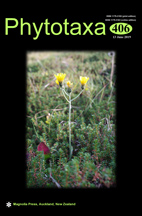Abstract
Arthrinium phyllostachium sp. nov. collected in Sichuan Province is described and illustrated from decaying culms of Phyllostachys heteroclada. Its phylogenetic placement is explored with a combined ITS, LSU, TUB2 and TEF 1-α dataset. It is introduced as a new novelty mainly based on phylogeny, and phylogenetic close to A. euphorbiae, A. malaysianum and A. vietnamensis, however it can be split from other taxa with a distinct clade and base pair differences. It is characterized by uni-loculate conidiomata with a slit-like opening, holoblastic conidiogenous cells and olive to dark brown conidia usually with a longitudinal germ-slit. An updated phylogram for Arthrinium based on multi-loci analysis is also provided.

